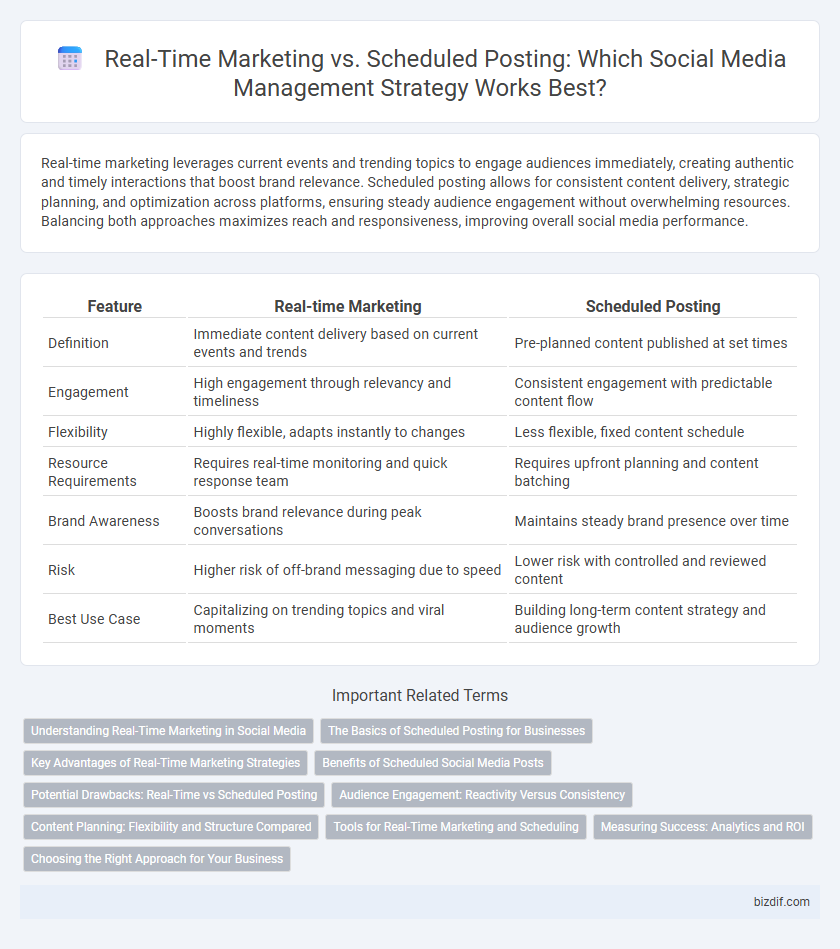Real-time marketing leverages current events and trending topics to engage audiences immediately, creating authentic and timely interactions that boost brand relevance. Scheduled posting allows for consistent content delivery, strategic planning, and optimization across platforms, ensuring steady audience engagement without overwhelming resources. Balancing both approaches maximizes reach and responsiveness, improving overall social media performance.
Table of Comparison
| Feature | Real-time Marketing | Scheduled Posting |
|---|---|---|
| Definition | Immediate content delivery based on current events and trends | Pre-planned content published at set times |
| Engagement | High engagement through relevancy and timeliness | Consistent engagement with predictable content flow |
| Flexibility | Highly flexible, adapts instantly to changes | Less flexible, fixed content schedule |
| Resource Requirements | Requires real-time monitoring and quick response team | Requires upfront planning and content batching |
| Brand Awareness | Boosts brand relevance during peak conversations | Maintains steady brand presence over time |
| Risk | Higher risk of off-brand messaging due to speed | Lower risk with controlled and reviewed content |
| Best Use Case | Capitalizing on trending topics and viral moments | Building long-term content strategy and audience growth |
Understanding Real-Time Marketing in Social Media
Real-time marketing in social media involves engaging with current events, trending topics, and live conversations to create timely, relevant content that resonates instantly with the audience. This approach leverages immediate data analysis and social listening tools to respond quickly, increasing brand visibility and relevance while boosting user engagement. Unlike scheduled posting, real-time marketing demands agility and prompt decision-making to capitalize on dynamic social media trends and consumer behavior shifts.
The Basics of Scheduled Posting for Businesses
Scheduled posting enables businesses to maintain a consistent social media presence by pre-planning and automating content distribution across multiple platforms. This strategy optimizes engagement by targeting peak audience activity times while reducing the need for constant manual updates. Leveraging analytics tools to determine optimal posting schedules enhances reach and maximizes ROI by aligning content delivery with user behavior patterns.
Key Advantages of Real-Time Marketing Strategies
Real-time marketing leverages immediate consumer engagement by responding swiftly to trending topics and events, boosting brand relevance and customer interaction. It enhances personalized communication, allowing brands to address audience needs dynamically and increase conversion rates. Immediate feedback and data collection enable rapid adjustments, optimizing campaign effectiveness and maintaining competitive advantage.
Benefits of Scheduled Social Media Posts
Scheduled social media posts provide consistent content delivery, increasing audience engagement by reaching users at optimal times based on analytics. This strategy enhances productivity, allowing marketers to plan and maintain a cohesive brand presence without constant manual input. Automation through scheduling tools also enables better resource allocation, freeing time for creative and strategic initiatives.
Potential Drawbacks: Real-Time vs Scheduled Posting
Real-time marketing requires immediate responses, which can lead to rushed decisions and increased risk of errors or inappropriate content. Scheduled posting allows for careful planning and consistency but may miss opportunities for timely engagement and trending topic relevance. Balancing spontaneity with preparedness is crucial to mitigate challenges inherent in both approaches.
Audience Engagement: Reactivity Versus Consistency
Real-time marketing drives audience engagement by capitalizing on current events and trends, fostering immediate interaction and relevancy. Scheduled posting ensures consistent content delivery, maintaining a stable presence and building long-term trust with followers. Balancing these strategies optimizes reactivity and consistency, enhancing overall social media performance and audience connection.
Content Planning: Flexibility and Structure Compared
Real-time marketing requires agile content planning, allowing brands to respond instantly to trending topics and audience interactions, maximizing engagement through timely relevance. Scheduled posting offers a structured framework, enabling consistent content delivery and strategic timing aligned with audience insights and campaign goals. Balancing flexibility with structure ensures optimal social media management, blending spontaneity with planned content to maintain brand presence and responsiveness.
Tools for Real-Time Marketing and Scheduling
Real-time marketing tools like Hootsuite, Sprout Social, and TweetDeck enable immediate engagement by monitoring trends and allowing instant content publishing. Scheduled posting platforms such as Buffer, Later, and HubSpot offer automated content planning, optimizing posting times based on audience insights for consistent brand presence. Combining real-time monitoring with scheduling tools enhances responsiveness while maintaining a strategic, steady social media flow.
Measuring Success: Analytics and ROI
Real-time marketing enables immediate engagement tracking through platform-specific metrics such as impressions, click-through rates, and sentiment analysis, offering instant insights into campaign effectiveness. Scheduled posting provides consistent content delivery with measurable performance over time, allowing for comparative analysis of audience growth and conversion rates. Combining these approaches enhances ROI measurement by leveraging real-time responsiveness alongside strategic content planning.
Choosing the Right Approach for Your Business
Real-time marketing leverages current events and trending topics to engage audiences instantly, boosting brand relevance and interaction. Scheduled posting ensures consistent content delivery by planning messages based on audience analytics, optimizing reach and timing without the pressure of immediate responses. Businesses should assess industry dynamics, target audience behavior, and resource availability to select the strategy that maximizes engagement and aligns with marketing goals.
Real-time marketing vs Scheduled posting Infographic

 bizdif.com
bizdif.com